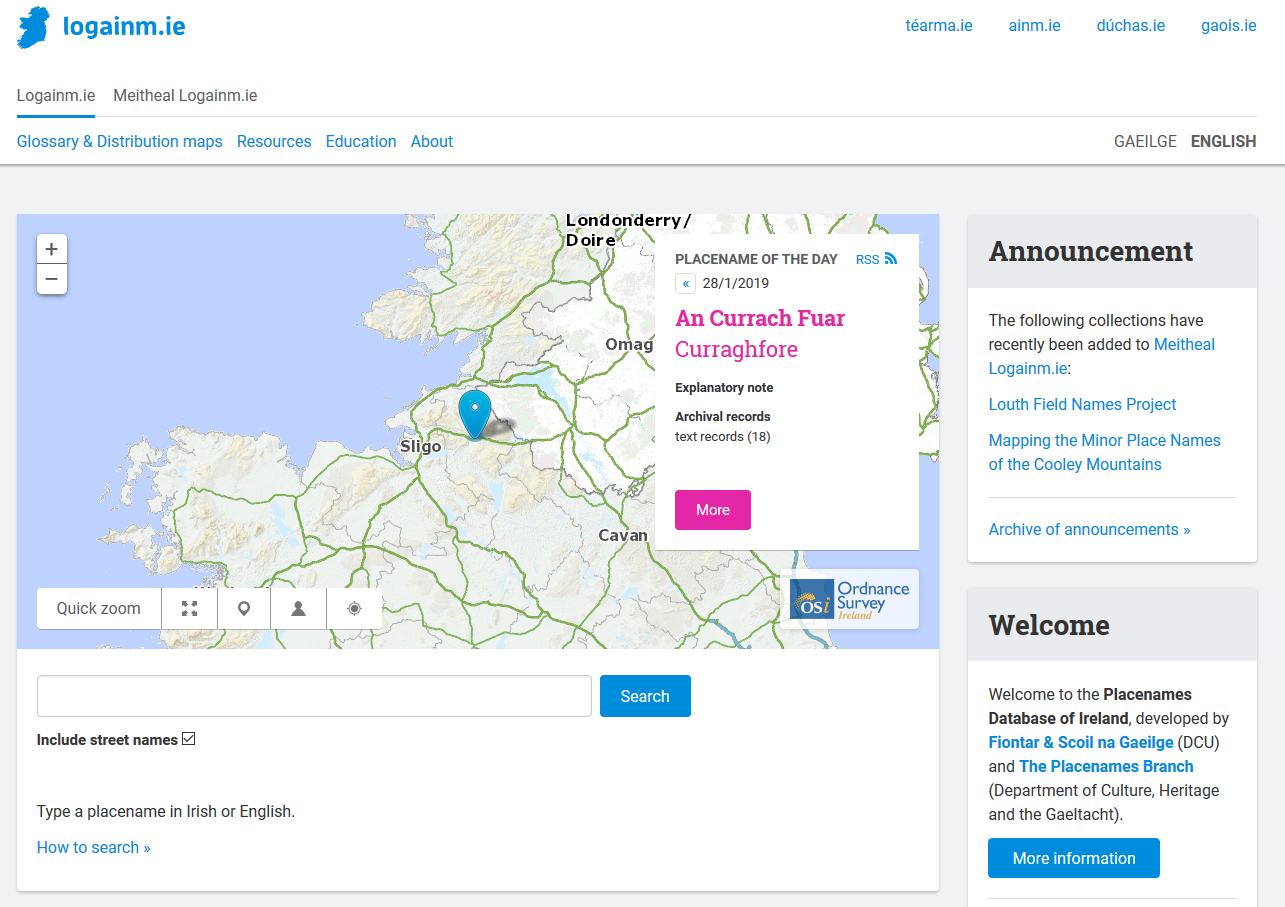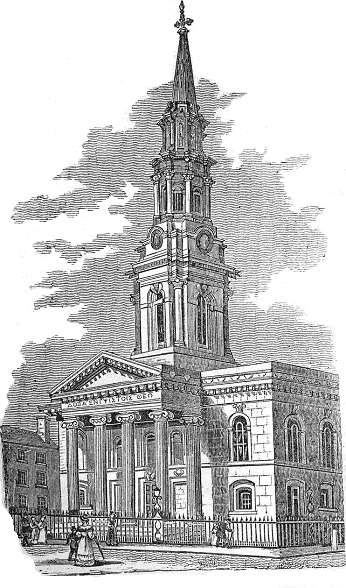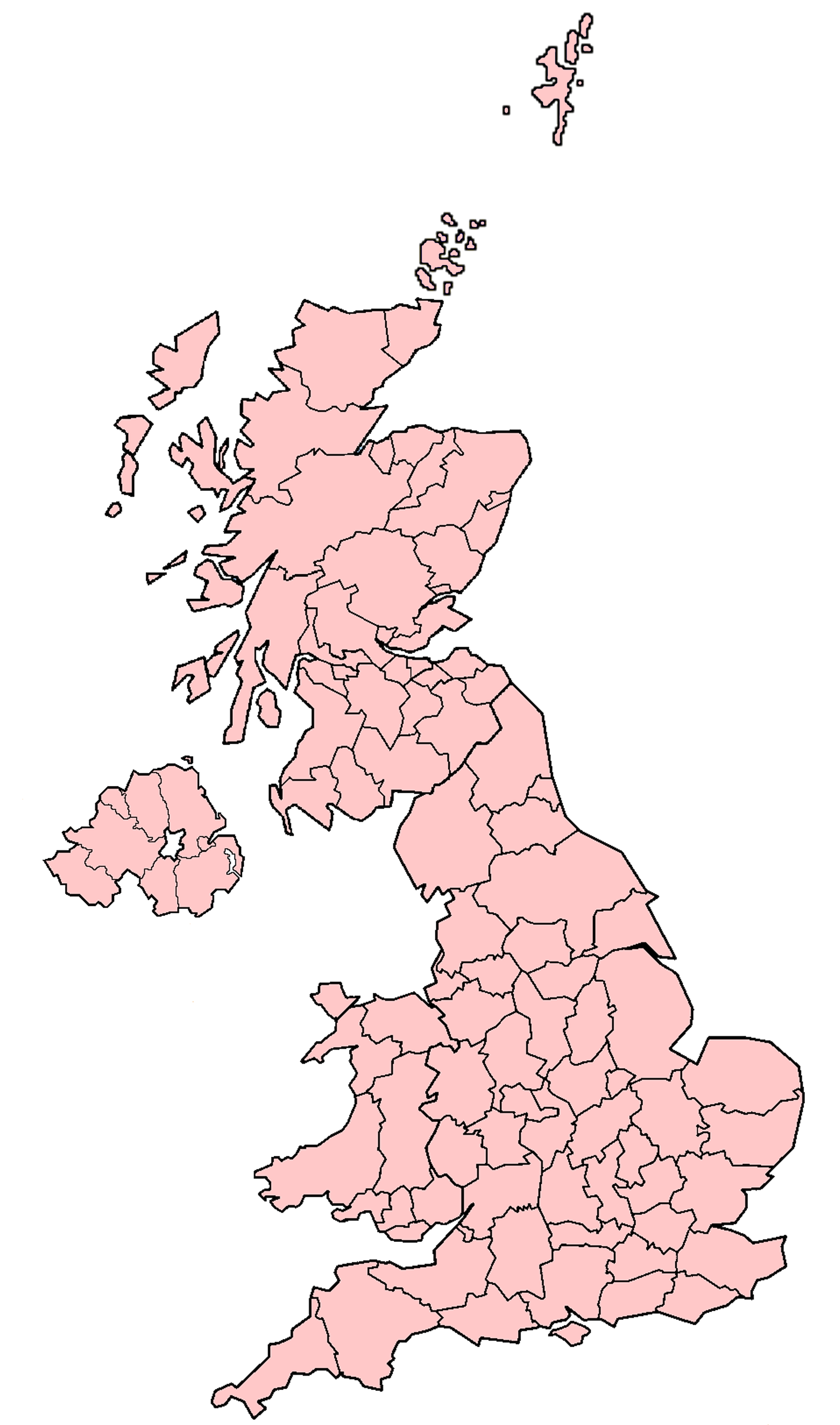|
St. Werburgh's Church, Dublin
St. Werburgh's Church is a Church of Ireland church building in Dublin, Ireland. The original church on this site was built in 1178, shortly after the arrival of the Anglo-Normans in the town. It was named after St. Werburgh, abbess of Ely and patron saint of Chester. The current building was constructed in 1719. It is located in Werburgh Street, close to Dublin Castle. The church In Celtic and Danish times, the parish was dedicated to St. Martin of Tours; the church stood near the south end of Werburgh Street. After St. Werburgh's Church was constructed it was much frequented by Bristol men, who were amongst the earliest settlers in Dublin. It contained chapels in honour of Our Lady, St. Martin and St. Catherine.Journal of the Royal Society of Antiquaries of Ireland (1915) p. 33 The original church was burned down in 1311 (along with much of the city) and was rebuilt. From the time of Archbishop Henry de Loundres (died 1228), St. Werburgh's was appropriated to the Chance ... [...More Info...] [...Related Items...] OR: [Wikipedia] [Google] [Baidu] |
Werburgh Street
Werburgh Street () is a street in the medieval area of Dublin, Ireland named for St. Werburgh's Church. Location Werburgh Street runs from Castle Street at the northern end, to Bride Street at the south, parallel with Patrick Street. History The street was originally St Werburgh Street, named after St. Werburgh's Church, with the street first appearing on maps in 1257. Werburgh Street Theatre was the first purpose-built theatre built in Ireland. In 1280 Sir Robert Bagod bought a stone dwelling house near Werburgh Street from the Hyntenberghs, a prominent Dublin family. In the fifteenth century, Roger Sutton had a house on the Street. It passed on his death to his son William Sutton, Attorney-General for Ireland.Ball, F Elrington ''The Judges in Ireland 1221-1921'' London John Murray 1926 p.179 The southern end of the street was the location of one of the gateways in the city's walls, known as St Werburgh's Gate or Pole Gate. In the 1600s, the southern end was also the lo ... [...More Info...] [...Related Items...] OR: [Wikipedia] [Google] [Baidu] |
Edward Wetenhall
Edward Wetenhall (1636–1713) was an English bishop of the Church of Ireland. His name is also spelled Wettenhall, Whetenhall, Whitnall, Withnoll, and Wythnall. Life Wetenhall was born at Lichfield on 7 October 1636. Educated at Westminster School under Richard Busby, he was admitted as a king's scholar in 1651, and went to Trinity College, Cambridge, as a foundation scholar. After graduating B.A. 1659–60, he migrated (1660) to Lincoln College, Oxford, of which he became chaplain, was incorporated B.A. 18 June, and graduated M.A. 10 July 1661. Wetenhall held the perpetual curacy of Combe Long, Oxfordshire, and the vicarage of St. Stephen's, near St Albans, Hertfordshire; on 11 June 1667 he was collated to a prebend at Exeter, holding with it the mastership (headmaster) of the blue-coat school. He graduated B.D. at Oxford 26 May 1669, and was incorporated B.D. at Cambridge 1670. Michael Boyle the younger, the Archbishop of Dublin, brought him over to Dublin in 1672, as maste ... [...More Info...] [...Related Items...] OR: [Wikipedia] [Google] [Baidu] |
George Frideric Handel
George Frideric (or Frederick) Handel ( ; baptised , ; 23 February 1685 – 14 April 1759) was a German-British Baroque composer well-known for his operas, oratorios, anthems, concerti grossi, and organ concerti. Born in Halle, Germany, Handel spent his early life in Hamburg and Italy before settling in London in 1712, where he spent the bulk of his career and became a naturalised British subject in 1727. He was strongly influenced both by the middle-German polyphonic choral tradition and by composers of the Italian Baroque. In turn, Handel's music forms one of the peaks of the "high baroque" style, bringing Italian opera to its highest development, creating the genres of English oratorio and organ concerto, and introducing a new style into English church music. He is consistently recognized as one of the greatest composers of his age. Handel started three commercial opera companies to supply the English nobility with Italian opera. In 1737, he had a physical breakdown, c ... [...More Info...] [...Related Items...] OR: [Wikipedia] [Google] [Baidu] |
Placenames Database Of Ireland
The Placenames Database of Ireland (), also known as , is a database and archive of place names in Ireland. It was created by Fiontar, Dublin City University in collaboration with the Placenames Branch of the Department of Tourism, Culture, Arts, Gaeltacht, Sport and Media. The website is a public resource primarily aimed at journalists and translators, students and teachers, historians and researchers in genealogy. Placenames Commission and Placenames Branch The Placenames Commission () was established by the Department of Finance in 1946 to advise Ordnance Survey Ireland and the government of what the Irish name of places should be. Although both the 1922 Constitution of the Irish Free State and the current constitution adopted in 1937 recognised Irish as the national language, the law in regard to placenames was carried over from the 19th-century UK statutes which established the Ordnance Survey and Griffith's Valuation, under which only an English-language name had offi ... [...More Info...] [...Related Items...] OR: [Wikipedia] [Google] [Baidu] |
Civil Parishes In Ireland
Civil parishes () are units of territory in the island of Ireland that have their origins in old Gaelic territorial divisions. They were adopted by the Anglo-Norman Lordship of Ireland and then by the Elizabethan Kingdom of Ireland, and were formalised as land divisions at the time of the Plantations of Ireland. They no longer correspond to the boundaries of Roman Catholic or Church of Ireland parishes, which are generally larger. Their use as administrative units was gradually replaced by Poor_law_union#Ireland, Poor Law Divisions in the 19th century, although they were not formally abolished. Today they are still sometimes used for legal purposes, such as to locate property in deeds of property registered between 1833 and 1946. Origins The Irish parish was based on the Gaelic territorial unit called a ''túath'' or ''Trícha cét''. Following the Norman invasion of Ireland, the Anglo-Normans, Anglo-Norman barons retained the ''tuath'', later renamed a parish or manor, as a un ... [...More Info...] [...Related Items...] OR: [Wikipedia] [Google] [Baidu] |
Francis Johnston (architect)
Francis Johnston (1760 – 14 March 1829) was an Anglo/Irish architect, best known for building the General Post Office, Dublin, General Post Office (GPO) on O'Connell Street, Dublin. Life Johnston was born in Armagh, Ireland, the son of architect William Johnston and younger brother of architect Richard Johnston he later also studied architecture. He practised in Armagh, and then lived in Drogheda from 1786 before moving to Dublin about 1793. In 1805, he was appointed to the Office of Public Works, Board of Works as an architect. In 1824 he was made president of the Royal Hibernian Academy of Arts which had been founded the previous year, and he provided headquarters for the academy in Lower Abbey Street at his own expense. Works Two early projects were the completion of Rokeby Park, Rokeby Hall and Ballymakenny Church, Co. Louth, to the designs of Thomas Cooley (architect), Thomas Cooley in whose office he first trained. In 1789 he was commissioned by Richard Robinson, 1 ... [...More Info...] [...Related Items...] OR: [Wikipedia] [Google] [Baidu] |
Lord Lieutenant
A lord-lieutenant ( ) is the British monarch's personal representative in each lieutenancy area of the United Kingdom. Historically, each lieutenant was responsible for organising the county's militia. In 1871, the lieutenant's responsibility over the local militia was removed. However, it was not until 1921 that they formally lost the right to call upon able-bodied men to fight when needed. Lord-lieutenant is now an honorary titular position usually awarded to a notable person in the county, and despite the name, may be either male or female, peer or not. Origins England and Wales Lieutenants were first appointed to a number of Historic counties of England, English counties by King Henry VIII in the 1540s, when the military functions of the sheriffs were handed over to them. Each lieutenant raised and was responsible for the efficiency of the local militia units of his county, and afterwards of the yeomanry and volunteers. He was commander of these forces, whose officers he a ... [...More Info...] [...Related Items...] OR: [Wikipedia] [Google] [Baidu] |
Surveyor General Of Ireland
The office of Surveyor General of Ireland was an appointed officer under the Dublin Castle administration of Ireland in the 17th and 18th centuries.McParland 1995 The Surveyor General was typically responsible for the surveying, design and construction of civic works, and was often involved in overseeing the construction of military barracks and public buildings. Though Surveyors General were officially appointed by the Lord Lieutenant of Ireland Lord Lieutenant of Ireland (), or more formally Lieutenant General and General Governor of Ireland, was the title of the chief governor of Ireland from the Williamite Wars of 1690 until the Partition of Ireland in 1922. This spanned the K ..., it was not unknown for the post to be "sold" by one holder to the next. For example, Arthur Jones-Nevill succeeded Arthur Dobbs in 1743, having paid £3,300 to secure the position. And despite being dismissed for maladministration, Nevill was allowed to sell the post on to Thomas Eyre in 1 ... [...More Info...] [...Related Items...] OR: [Wikipedia] [Google] [Baidu] |
Naas
Naas ( ; or ) is the county town of County Kildare in Republic of Ireland, Ireland. In 2022, it had a population of 26,180, making it the largest town in County Kildare (ahead of Newbridge, County Kildare, Newbridge) and the List of urban areas in the Republic of Ireland, fourteenth-largest urban centre in Ireland. History The name of Naas has been recorded in three forms in Irish Language, Irish: , translating as 'Place of Assembly of the Kings'; , translating to 'the Place of Assembly'; and , translating to 'Place of assembly of the Leinster Men'. Irish mythology suggests that the name arose as the burial site of Nás (a wife of Lugh of the Tuatha Dé Danann, Tuatha De Danann). It is also said to be where Lugh held his royal court. Nás was said to have been buried on The Moat Hill (Dún Nás). The Book of Leinster contains the Dindsenchas (lore of places) of Naas with the following verses discussing where the name supposedly came from.:“(Nás)… claims of right the br ... [...More Info...] [...Related Items...] OR: [Wikipedia] [Google] [Baidu] |
Thomas Burgh (1670–1730)
Colonel Thomas de Burgh ( ; 1670 – 18 December 1730), always named in his lifetime as Thomas Burgh, was an Anglo-Irish military engineer, architect, and Member of the Parliament of Ireland who served as Surveyor General of Ireland (1700–1730) and designed a number of the large public buildings of Dublin including the old Custom House (1704–6), Trinity College Library (1712–33), Dr Steevens' Hospital (1719), the Linen Hall (1722), and the Royal Barracks (1701 onwards). Early life Thomas Burgh was the son of Rt Rev Ulysses Burgh (d. 1692) of Drumkeen, County Limerick, who was Dean of Emly and later Bishop of Ardagh. His mother was Mary, daughter of William Kingsmill of Ballibeg, County Cork. His brothers, Richard Burgh of Dromkeen and Drumrusk and William Burgh of Bert House, Athy, were both Members of the Irish Parliament. Thomas was educated at Delany's school in Dublin, and Trinity College, Dublin, where he matriculated on 22 November 1685 and left without t ... [...More Info...] [...Related Items...] OR: [Wikipedia] [Google] [Baidu] |
Parliament Of Ireland
The Parliament of Ireland () was the legislature of the Lordship of Ireland, and later the Kingdom of Ireland, from 1297 until the end of 1800. It was modelled on the Parliament of England and from 1537 comprised two chambers: the Irish House of Commons, House of Commons and the Irish House of Lords, House of Lords. The Lords were members of the Peerage of Ireland, Irish peerage ('Lords Temporal, lords temporal') and Bishop, bishops ('Lords Spiritual, lords spiritual'; after the Reformation, Church of Ireland bishops). The Commons was directly elected, albeit on a very restricted Suffrage, franchise. Parliaments met at various places in Leinster and Munster, but latterly always in Dublin: in Christ Church Cathedral, Dublin, Christ Church Cathedral (15th century),Richardson 1943 p.451 Dublin Castle (to 1649), Chichester House (1661–1727), the The King's Hospital, Blue Coat School (1729–31), and finally a purpose-built Parliament House, Dublin, Parliament House on College G ... [...More Info...] [...Related Items...] OR: [Wikipedia] [Google] [Baidu] |
Statute Law Revision (Ireland) Act 1878
The Statute Law Revision (Ireland) Act 1878 ( 41 & 42 Vict. c. 57) is an act of the Parliament of the United Kingdom that repealed for Ireland enactments of the Parliament of Ireland from 1310 to 1747 which had ceased to be in force or had become necessary. The act was intended, in particular, to facilitate the preparation of the revised edition of the Irish statutes, then in progress. Background In the United Kingdom, acts of Parliament remain in force until expressly repealed. Blackstone's Commentaries on the Laws of England, published in the late 18th-century, raised questions about the system and structure of the common law and the poor drafting and disorder of the existing statute book. In 1806, the Commission on Public Records passed a resolution requesting the production of a report on the best mode of reducing the volume of the statute book. From 1810 to 1825, The Statutes of the Realm was published, providing for the first time the authoritative collection of a ... [...More Info...] [...Related Items...] OR: [Wikipedia] [Google] [Baidu] |






